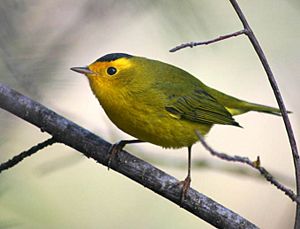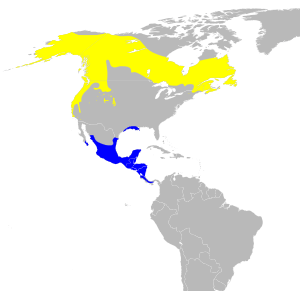Wilson's warbler facts for kids
Quick facts for kids Wilson's warbler |
|
|---|---|
 |
|
| Adult male | |
| Conservation status | |
| Scientific classification | |
| Genus: |
Cardellina
|
| Species: |
pusilla
|
 |
|
| Range of C. pusilla Breeding range Wintering range | |
| Synonyms | |
|
Muscicapa pusilla (protonym) |
|
The Wilson's warbler (Cardellina pusilla) is a small, colorful bird. It is a type of New World warbler, which means it's a small songbird found in North and South America. This bird is mostly green on its back and bright yellow underneath. It has round wings and a long, thin tail. Male Wilson's warblers have a special black cap on their heads. Females might have a smaller cap or no cap at all, depending on where they live.
These warblers breed, or have their babies, in Canada and the western United States. When winter comes, they fly south to warmer places like Mexico and Central America. Sometimes, very rarely, one might even fly all the way to western Europe by mistake!
Contents
About the Wilson's Warbler
The Wilson's warbler was first officially described in 1811 by a bird expert named Alexander Wilson. He gave it the scientific name Muscicapa pusilla. The word pusilla means "very small," which fits this tiny bird perfectly.
Over time, scientists moved the Wilson's warbler into different groups, or genera. A genus is a group of closely related species. Today, it is placed in the genus Cardellina. The name Cardellina comes from an Italian word for the European goldfinch.
Different Kinds of Wilson's Warblers
There are three main types, or subspecies, of Wilson's warblers:
- C. p. pusilla: This type was described by Alexander Wilson in 1811.
- C. p. pileolata: This type was described by a German naturalist named Peter Simon Pallas in 1811.
- C. p. chryseola: This type was described by Robert Ridgway in 1902.
The chryseola subspecies lives in northern coastal California and southwestern coastal Canada. These birds have a unique orange-yellow color on their foreheads. Sadly, the number of chryseola warblers has gone down a lot. This is because they fly to the southern part of Mexico for winter, and many of their natural homes there have been replaced by new buildings and resorts.
What Does It Look Like?
The Wilson's warbler is a small passerine bird, which means it's a perching bird. It is about 10 to 12 cm (3.9 to 4.7 in) long. Its wings can spread about 14–17 cm (5.5–6.7 in) wide, and it weighs about 5–10 g (0.18–0.35 oz).
It has a plain green-brown back and bright yellow feathers on its belly. The male bird has a clear black cap on its head. Males from the western C. p. chryseola group are often greener and brighter than those from the eastern group. Birds from Alaska and the central western parts of their range are a bit bigger than those found in the east or along the Pacific coast.
The Wilson's warbler's song is a fast, chattering sound that goes down in pitch. Its call is a flat "chuff."
Sometimes, people might confuse the Wilson's warbler with the yellow warbler. But you can tell them apart because the yellow warbler has a different body shape, and it has yellow markings on its wings and tail.
Where Do Wilson's Warblers Live?
Wilson's warblers like to live in open woodlands with lots of bushes and shrubs. They especially like wet areas near streams, ponds, and bogs.
They breed in northern Canada and the western United States. In winter, they move to places like overgrown clearings, coffee farms, and the edges of forests. They can also be found in tropical forests, pine-oak forests, and areas with lots of bushes. They prefer places where new plants are growing, or forests near rivers and in mountains. As mentioned, it's very rare for them to be seen in Western Europe.
Behavior and Life Cycle
How Do They Reproduce?
Wilson's warblers usually start building their nests in early March in warmer coastal areas, and later in the summer in northern regions. The female bird does most of the nest building. She makes a cup-shaped nest out of plants and lines it with soft grasses and hair. The nest is often hidden in moss or tall grasses at the bottom of bushes.
A female will lay between 2 and 7 eggs. The eggs are usually creamy white with small reddish spots. The baby birds are born altricial, which means they are helpless and need their parents to feed and care for them. The eggs hatch in 11 to 15 days, and the young birds are ready to leave the nest in 8 to 13 days. Their parents continue to care for them for several more weeks.
In some mountain areas, one male Wilson's warbler might mate with more than one female. The Wilson's warbler is also often a host for the brown-headed cowbird. This means that brown-headed cowbirds sometimes lay their eggs in a Wilson's warbler's nest, and the warbler parents end up raising the cowbird chicks.
What Do Wilson's Warblers Eat?
Wilson's warblers are insectivores, meaning they mainly eat insects. They find insects by picking them off leaves and twigs, or by catching them in the air. Some of the insects they eat include beetles, bees, and caterpillars.
The Wilson's warbler is a very active bird when it's looking for food. It moves quickly through bushes, on the ground, and sometimes even in taller trees during the winter. When they are feeding, these birds often twitch their tails or quickly flick their wings. They also eat a few berries.
See also
 In Spanish: Chipe coroninegro para niños
In Spanish: Chipe coroninegro para niños


